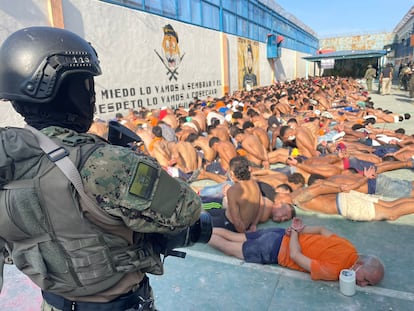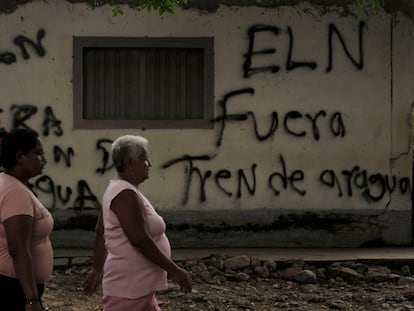Hell at the gates of Litoral, the most dangerous prison in Ecuador
Relatives of the victims of the latest massacre at the Guayaquil penitentiary have been waiting for days to identify the bodies of their loved ones

This is Patricia’s fourth day outside the Litoral Penitentiary, the most dangerous prison in Ecuador. She has not been able to raise the money to pay for a coffin to remove the body of her brother, one of the prisoners who was killed in a massacre on July 25. “I’m waiting for the residents in the neighborhood to help us so we can take him out and take him home,” says the 58-year-old woman.
After the massacre, the penitentiary and the morgue have become postcards of pain. No state institution is responsible for what happened and they deliver information in dribs and drabs, leaving the families to plead to find out where the bodies of their loved ones are. Many of them are severed or burned, making identification difficult. A tattoo, a birthmark, or some vestige of remaining clothing can provide clues but the identification process of the human remains, carried out via genetic analysis, will take more time.
Only 11 bodies removed from the penitentiary have been identified, among them Patricia’s brother. She found out what happened from a friend who had a relative in the same cellblock — number nine — where her brother was being held. “I had seen the news about the killings, but I never imagined that he was among the dead,” she says, reaching for some photos in her purse. They show her brother’s corpse, with machete wounds on his body, lying on the floor. Others show his face, arm, and leg, and in one he is wearing his security guard’s uniform. “That one was just before they put him in jail. He worked for a company and they accused him of robbery. They gave him three years, and he had already done more than one here.”
Those who have been able to raise the necessary money have removed the corpses of their loved ones and discreetly buried them immediately. Gone are the days of watching over the dead for three consecutive nights, as tradition dictates. “This is a mess, it is total corruption; everyone wants money, one asks for information and they do not give us any. They tell us straight out: how much [money] is there for the queues?” says Patricia, who lives in Puerto Bolivar, four hours from Guayaquil. She arrived with $10 and survives with the help of other relatives who understand her position. “The state has not even taken care of the funeral expenses of those killed in that hell, which is under its responsibility,” says Ana Morales, spokeswoman for the Committee of Relatives for Justice in Prisons.
Ana went through the same situation after the massacre of September 28, 2021, the worst in Ecuadorian history, when 123 prisoners at the Litoral Penitentiary were killed, including her 23-year-old son. Since then, there have been 10 further massacres in prison riots in Ecuador and there is still no protocol in place to attend to the families. After the latest massacre, she went to the morgue to help the relatives and found nothing had changed since 2021. “There was no one from the state; the Ministry of Health was not there, there was no psychologist to help the fathers and mothers who were looking for their children. They had no information, there was no one to follow up. The treatment was the same.”
The macabre process of identification begins when a guard, list in hand, calls out the surname of the relatives, who are crowded under the only tree on the sidewalk, seeking shade from the intense heat. Grandmothers wipe away their sweat and tears with a towel. They all wait nervously as the names are shouted out. When the inevitable happens, they burst into tears and are called to identify the body or body parts of their grandchildren, sons, husbands, and brothers.
The number of prisoners killed in what was the seventh massacre at the Litoral Penitentiary is still uncertain. The Prosecutor’s Office reported that 31 bodies were recovered, but the police later stated there were 11 intact corpses and 29 anatomical pieces. The Ecuador prisons service, SNAI, has not provided a concrete answer.
The authorities claim to have taken control of the prison, publishing photographs of prisoners cuffed and subdued under armed guard, following the model implemented by Nayib Bukele in El Salvador. This is how Jéssica realized that her son was alive: he was transferred from the cell blocks wearing nothing but boxer shorts, exactly as he appears in the photograph posted by President Guillermo Lasso on Twitter. “Now I have to buy everything again; the mattress, clothes, his cleaning utensils, because they left him with nothing,” says the mother.
“It was a war”
Detonations are still sporadically heard from inside the penitentiary, which has been militarized after the state of emergency decree signed by Lasso. Raids have turned up weapons and thousands of rounds of ammunition.
What happens inside the Litoral Penitentiary is a permanent unknown. Only those who have been incarcerated there know the truth. Brian (a fictitious name to protect his identity), 27, served a four-year sentence in the prison and was paroled four months ago. During his time there, he witnessed the killings and is unsure how he survived. “As soon as I heard a gunshot, I would run to the women’s prison. There were a few of us and we had to break through the wall to hide and wait for things to calm down. It was a war.”
The Litoral Penitentiary is located within a complex that houses four other prisons, including the women’s prison, a maximum-security facility called La Roca, where some gang leaders have been transferred, and the regional prison, which is under the control of the head of the Los Choneros criminal organization. In total, these prisons hold 12,300 inmates in infrastructures with a maximum capacity of no more than 9,500.
Sign up for our weekly newsletter to get more English-language news coverage from EL PAÍS USA Edition









































